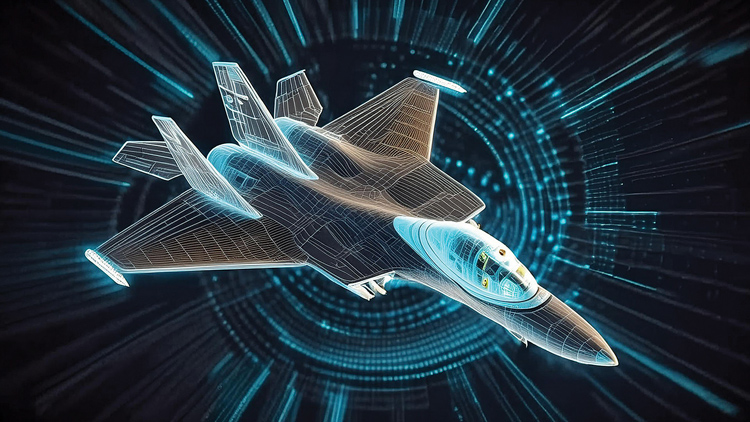Technology Infusion into the IAF
We can leverage the transformative power of emerging technologies to strengthen our security and stability if policymakers and military leaders can address the challenges of balancing innovation with ethical and practical considerations

We will fight with what we have" is an often-repeated phrase by military leaders trained in service to extract the best from available resources, develop newer tactics, and innovate in the usage of the equipment. Everyone charged with the responsibility of defending the nation understands that no country can afford to discard equipment because the technology is outdated. However, the question arises of how to keep pace with new technologies while still operating large numbers of vintage equipment. By the time one got comfortable with 386 processor based computers, the market was flooded with 486 computers and then soon with Pentium computers. Similarly, the military hardware that came with the latest generation of microprocessors soon required updates, consuming large chunks of the revenue budget.
SIGNIFICANCE OF EMERGING TECHNOLOGIES
Today, no article, speech or presentation on the future of armed forces is complete without mentioning Artificial Intelligence (AI). This term has crept into our lexicon in the last decade, while AI applications have been abundantly used for over a quarter of the century across the world. AI technologies have enabled computers to perform a wide variety of functions, including analysing data, translating texts and even making recommendations.
In addition to AI, other technologies are shaping the future of military operations. For example, advances in robotics are leading to the development of more sophisticated unmanned systems for air, land, and sea operations. Hypersonic weapons, capable of travelling at speeds exceeding Mach 5, require AI systems for precise targeting and manoeuvring. Meanwhile, quantum computing holds the potential to revolutionise encryption and decryption processes, offering unprecedented levels of security and computational power.
Space technologies are also becoming a critical component of military strategy. AI plays a key role in satellite management, space situational awareness, and the development of counter-space capabilities. As the militarisation of space becomes a reality, the integration of AI and advanced technologies will be essential to maintaining a strategic advantage.
This article will focus on the possibilities for the use of AI in different realms of military domains.
AI IMPETUS TO MULTI-DOMAIN OPERATIONS
Most of the computers in use in the armed forces are embedded within a weapon system, aircraft, or a ship. The exploitation of AI began with the networking of radars and radio equipment and the setting up of advanced C2 centres. Initially, AI was used for target recognition based on multiple parameters. For example, in an air defence (AD) system, the computer was 'taught' the correlation of height, speed, the likely type of aircraft and the direction of approach to warn the operator about the emerging threat and provide a basic form of decision support.
The rapid advancement of AI and other emerging technologies is reshaping the landscape of military operations and defence strategies worldwide. These technologies promise to enhance efficiency, precision, and decision-making capabilities while introducing new challenges that require careful navigation. As nations strive to maintain a strategic edge, AI and related innovations are becoming integral to modern military operations, impacting everything from logistics to combat scenarios.
If one were to list out the futuristic requirements of AI tools, they would be, in no particular order, as follows:
Psychological analysis of candidates seeking to join the armed forces, either as officers or even as Agniveers, could be carried out based on parameters like eye/retina movements and/or heart rate while facing mental ability tests or interviews. Such AI tools would save long hours spent evaluating candidates and help identify the correct temperaments.
As an aid to training, AI systems can bring about a revolution. From bringing in more realism in simulators to creating self-learning modules, the possibilities are endless. AI-driven virtual reality (VR) and augmented reality (AR) systems provide realistic training environments. While the same is being exploited in stand-alone systems, integrating multiple AR/VR based simulators can greatly enhance technical training, especially when limited time for training is available.
Assessment of flying skills based on analysis of flight data recorders can remove subjectivity in marking and grading pilot skills. Even in basic flying training, the objective should be to move away from "industrial age" training models with pre-set timetables and instruction plans to one that adapts to each trainee's learning pace.
With the impending introduction of fifth-generation aircraft and systems of into the Air Force, we will need novel training patterns. Today, a young pilot in a standard air superiority fighter doesn't have to think like a mission commander until he acquires the expertise and progresses to become a mission leader. But in the next generation aircraft, due to their power to be able to 'see' across the visible and the electromagnetic spectrum, every cockpit will have large amounts of data being generated, and every pilot will have to be trained like a mission commander from day one. Pilots in fifth generation aircraft cockpits will be able to direct large formations and make decisions based on the big picture of the battle because they will see things that others cannot, and like edge computing, they will have to process large amounts of data. Normally, it takes years to train somebody to attain that kind of cognitive complexity to be able to do multi-domain order of battle decision making, but thanks to available and emerging AI tools, the new generation of aircrew will be able to do it in much shorter periods.
War gaming and exercise planning during peacetime occupy a lot of mind space of the operational staff at training establishments. Simulations using AI can replicate battlefield scenarios, allowing personnel to train in diverse and adaptive conditions.
One of the biggest challenges in the maintenance of diverse equipment is the timely provisioning of spares. Predictions based on past consumption data and stock holdings often lead to overstocking or shortfalls. AI tools can be effectively used to plan for provisioning and storage of spares with minimal disruptions to the servicing schedules, thereby reducing the downtime of any weapon system or equipment. In addition, AI contributes to the optimisation of logistics and supply chain management. Predictive maintenance powered by AI increases the reliability and longevity of military assets. By predicting maintenance needs, planning efficient routes, and automating resource distribution, AI can ensure that military operations are supported effectively and with minimal delays. These efficiencies can significantly increase the success of missions, particularly in remote or contested areas, through efficient resource management and supply distribution by minimising costs and time in transportation and delivery.
AI is driving significant changes across various military domains, particularly in automation, data analysis, and decision support systems. Autonomous systems, such as drones and unmanned vehicles, exemplify this transformation. These systems can carry out reconnaissance, surveillance, and even combat missions in hazardous environments, reducing the risk to human personnel. AI's ability to process data in real time also enhances intelligence, surveillance, and reconnaissance (ISR) capabilities by identifying patterns and anomalies that may signal potential threats. AI-powered decision support systems are revolutionising command and control operations. These systems can process vast amounts of data from sensors, satellites, and human inputs to provide actionable intelligence. Predictive analytics allow military leaders to anticipate enemy movements, evaluate tactical options, and simulate potential outcomes. AI-driven systems assist commanders by analysing complex scenarios and providing data-driven recommendations.
Such capabilities not only improve situational awareness but also reduce the time required to make critical decisions, while predictive models help commanders anticipate enemy actions and plan operations.
AI BUILDING COMMUNICATION SHIELD
Electronic warfare (EW) is a vital domain of warfare, and superiority over it will determine the outcome of any conflict. AI tools and AI-supported EW equipment can jam or spoof enemy communications while protecting friendly systems with little human intervention. Machine learning helps analyse and counter radar or signal threats in electronic warfare scenarios. Collation, analysis and dissemination of electronic intelligence (ELINT) data can be efficiently handled by AI based systems and can be integrated across the users of the spectrum.
Similarly, ISR, the key element of military planning, requires analysing vast amounts of data from sensors, satellites, and cameras to detect patterns, predict threats, and provide actionable intelligence. AI enhances ISR capabilities by integrating elements such as advanced computer vision that enable real-time identification of objects, personnel, or activities of interest with the EW database.
In the realm of cybersecurity, AI is proving indispensable. Military systems are prime targets for cyberattacks, and machine learning algorithms help detect and mitigate threats by analysing network activity for irregularities. AI can also automate responses to cyber breaches, ensuring swift and efficient countermeasures.
For human resource (HR) management, AI applications can sift through large volumes of appraisal reports to identify the right person for the right job. Career planning based on multiple inputs can be made easier. Predictive analysis of the outcome of any HR policy change helps the leadership to make well-informed, data-driven decisions that would stand the test of legal scrutiny.
Among the factors that motivate personnel to dedicate themselves to the service of the nation, the most important are decent housing and schooling. AI modules can help the administrators determine their availability across the country for better planning of accommodation, maintenance and allotment, especially in a joint service environment.
ETHICAL DIMENSIONS
Despite the numerous benefits, the integration of AI and new technologies into the military will always raise significant ethical and strategic concerns. One of the most debated issues is the use of autonomous weapon systems capable of lethal action without human intervention. Critics argue that delegating life-and-death decisions to machines poses moral and legal challenges, particularly in ensuring accountability.
Another concern is the reliability and bias of AI systems. Errors in data or algorithmic design could lead to unintended consequences, especially when the security of the nation is involved. Adversaries could also exploit vulnerabilities in AI systems and this will require robust countermeasures and continuous innovation.
The global nature of technological development further complicates matters. As nations compete to develop and deploy these technologies, there will be a need to establish regulatory frameworks and reliable means to mitigate the risks of adversarial AI.
WAY AHEAD
The future of AI and new technologies in the military holds immense promise and profound implications. Human-AI collaboration is expected to be a key focus, ensuring that technological advancements augment rather than replace human decision-making. The development of AIenabled swarming drones, where large numbers of autonomous systems operate in coordination and often in conjunction with manned systems, is likely to redefine battlefield strategies. Similarly, advancements in AI-driven simulations and training tools will prepare military personnel for increasingly complex operational environments. The future lies in planning and procuring open architecture systems that give the users the freedom to add on or plugin newer hardware or change the software without going back to the original equipment manufacturer (OEM). Open architecture in mission computers of fighter aircraft will give the flexibility to integrate new weapons and EW systems. Similarly, open architecture servers in AD systems will allow the expansion of the AD coverage zone by simply plugging in a new radar or missile system.
CONCLUSION
Indian Air Force (IAF) has remained abreast of technological developments and has capitalised on the prowess of AI, incorporating it in HR management, meteorological services, maintenance planning and many operational planning tools. The focus should now shift towards setting up joint AI application development centres and combining the capacities of Defence Research and Development Organisation (DRDO) labs with those of the services so that common applications are available to all users simultaneously.
As these technologies continue to evolve, it is imperative for policymakers and military leaders to address the associated challenges responsibly. By balancing innovation with ethical and practical considerations, we can harness the transformative potential of AI and new technologies to enhance security and stability in an increasingly uncertain world.
The author retired as Chief of the Air Staff, Indian Air Force on September 30, 2024.





